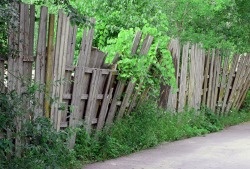 People choose to build a fence for many different reasons including landscape decoration, privacy, keeping pets contained, and more. A fence installation is an investment, and the result is something that should be a source of pride. Be sure to avoid these seven common mistakes that can instead broadcast to everyone in the neighborhood that you made a mistake when you built your fence:
People choose to build a fence for many different reasons including landscape decoration, privacy, keeping pets contained, and more. A fence installation is an investment, and the result is something that should be a source of pride. Be sure to avoid these seven common mistakes that can instead broadcast to everyone in the neighborhood that you made a mistake when you built your fence:
1. Ignoring your neighbors and property lines
Your city or town or even condominium association will likely have specific requirements for adding a fence to your property, which can include how close to the property line the fence may be installed, or how high it can be. Some governing bodies are stricter than others, but it is important to follow the guidelines set forth. A professional surveyor should be used to properly mark your property lines. Your friendly neighbor may not mind if your fence is right on his property line, but in a couple of years when that neighbor moves, your new neighbor may have an issue with it.
2. Not enough height
When thinking about how high your fence needs to be, it is important to not just think about your current needs but also your future needs. Maybe you currently have a 20-pound dog that doesn’t jump so a four-foot fence is appropriate. But in a few years, you decide to install a swimming pool, and your city requires a six-foot fence. Be sure to consider your needs for the next 10 years when designing your fence.
3. Too much maintenance
Fences can be made from many different materials including aluminum, wood, PVC, vinyl, chain link or wrought iron. Each type has positives and negatives, so it's important to understand what kind of maintenance may be required in the future. There is nothing worse than a shabby looking fence in your backyard, and your city may eventually even go so far as fining you for not providing proper upkeep.
4. Lose or corroded fasteners
Using subpar materials to save money on installation is a big mistake, causing you to end up spending even more money on repairs. It's important, therefore, to use strong fasteners that are high quality, sized correctly for the job, and weather-resistant. The BECK® Fence Stapling System relies upon air-driven fence stapling, boasting superior holding power and corrosion protection, and creating a reliable, long term fence fastening solution. The fence stapler is ideal for attaching any type of wire fencing to wood, including chain link fences, barbed wire, high tensile wire, animal cages, and livestock panel enclosures.
5. Collapsing fence
Fence posts are the backbone of any fence project and need to be installed properly. If the postholes are not deep enough or not anchored correctly, they could fall over, making the whole fence collapse. Posts should be installed at least two feet into the ground, and anchored by both gravel and concrete that is level with the ground.
6. Heavy gate
A common mistake for homeowners is when they build the gate themselves, and it ends up being very heavy. This can happen when the hinges are not the proper size to hold the gate. For example, a pressure-treated gate can be very heavy to start with, and can become even heavier when it rains. Be sure the hinges are the right size to hold the gate’s weight, taking into account the gate’s material.
7. Improper location and size of gates
How will you enter your fenced in area, and what equipment will you need to move through your fence? Just a lawn mower? Small earth moving equipment? Not enough gates or gates in the wrong place or gates that are too small can all be a real pain for a homeowner. Plan how you want to access the fenced in area ahead of doing the build. Gates for people can be 3 feet wide, but larger equipment such as lawn mowers, tractors, wheelbarrows and garden carts need 4-foot wide gates or possibly two 3-foot gates. It’s best to have multiple entry points, and at least one gate that is oversized to accommodate any larger equipment that you may need to pass through the opening down the road.
With proper planning and materials, you can avoid these fence issues and have a fence that you can enjoy for many years. To learn more about using strong and weather resistant fasteners for your fencing project, watch the video about the BECK® Fence Stapling System.
.svg.png)

